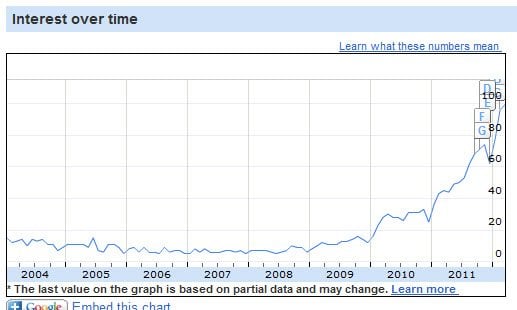We live in an age of “Big Data“..which means there is more data than ever before.
In one day we create 1.5 billion pieces of content, 140 million tweets and 2 million videos.
Trying to make sense of the mountains and oceans of data that are now part of our knowledge world due to computers, mobiles and the web is a daily challenge.
- Do you bookmark, file it or Evernote the link or PDF?
- Do you punch the reference into your iPhone or iPad
- Do you grab a pen and jot it down on your beloved Moleskine notepad?
We constantly are attempting to organise, collate and curate information that pours at at as from screens in a torrent.
Consuming that data is like drinking from a fire hose.
What are Infographics?
They are a mix of design, writing and analysis that are ideal for an age of big data. (just like you see at the top of this page)
Some other examples can be found here -“6 Fantastic Facebook Marketing Infographics“.
Infographics are a visually compelling communication medium that done well can communicate complex data in a visual format that is potentially viral.
They take deep data and present it in a visual shorthand.
“Infographics” is one efficient way of combining the best of text, images and design to represent complex data that tells a story that begs to be shared.
What Research Reveals about Infographics
Recent research from Barbara M. Miller and Brooke Barnett discovered this about “Infographics”
“On their own, text and graphics are both useful yet imperfect methods for communication. Written language allows an almost infinite number of word combinations that allow deep analysis of concepts but relies heavily on the reader’s ability to process that information. Graphics may be easier for the reader to understand but are less effective in communication of abstract and complicated concepts. … combining text and graphics allows communicators to take advantage of each medium’s strengths and diminish each medium’s weaknesses.”
Does your industry need to present data in an effective manner to communicate and engage its customers and prospects?..Then infographics could be part of the answer.
The Growth of Infographics
I noticed the power of Infographics about 6 months ago when I included it in blog article and was surprised by the traffic response. On taking a closer look at its popularity, I decided to use Google “Insights for Search” analytics to determine the increase in the interest in the keyword “Infographics” as reflected in search volume increases since 2004. 
Statistics from the social network Digg reveal that since 2007, infographics on Digg have increased by 250 times!
Now that is a trend wave worth catching!
Why Include Infographics in your Content Marketing Strategy?
When it comes down to it Infographics they may be a compelling but why use them?
Source: Web Marketing Group
1. Compelling and Attractive
There is one thing that I have discovered while blogging is that people love facts, figures and statistics. Add some compelling images and graphics and …”voila“, you have addictive content!
2. Easily Scanned and Viewed
Human beings are highly visual and because 90% of of the information that comes to the brain is visual you need to tap into that “optic nerve”
3. Viral Capabilties
Due to infographics attractiveness the capacity for them to be shared on social networks and become viral is much higher than ordinary text content.
4. Portable (Embeddable)
When designing, developing and publishing an infographic the code to put it on a WordPress blog or website is provided as an embed code. This then creates an automatic link from their site to yours.
5. Worldwide Coverage
In a world where online publishing is now visible globally at the push of a button, infographics can provide global coverage that local print media could never do.
6. Brand Awareness
Creating an infographic that is embedded with your logo and brand displayed is a powerful means of creating a greater “Brand Awareness”
7. Increases Traffic
An infographic that is linked and compelling by its nature will drive traffic to your website band blog as people “share” and “click”
8. Benefits Search Engine Optimisation
The viral nature of the infographic medium makes people link to your site and Google will index your website higher due to Google’s “Page Rank” algorithm. This increases the importance that search engines pace on your site.
9. Shows an Expert understanding of a Subject
The research required to create an infographic will display your knowledge and position you as an expert on your category or topic.
The challenge with infographics is creating them and the right infographic creator can go a long way towards your success.
There are new tools and platforms emerging that make creating them easier such as Statsilk.com and Visual.ly
How about You?
Have you created or used infographics? Have they driven traffic and created more brand awareness for your business?
Look forward to hearing your stories.
More Reading
- Why Business Should take an Interest in Pinterest
- 30 Resources, Tips and Tricks for Marketing Your Business on Pinterest
- Pinterest Drives more Traffic than LinkedIn and Google Plus
- 7 Ways to Use Pinterest to Promote your Business – Plus Infographic
- 6 Social Media Networks to Watch in 2012 – Plus Infographics
- Social Media Sharing Trends in 2011- Infographic
- 7 Top Trends in Social Media
The post 9 Awesome Reasons to Use Infographics in your Content Marketing appeared first on Jeffbullas’s Blog.
Read Full Article: http://bathseoexpert.tumblr.com/post/168439460251


No comments:
Post a Comment